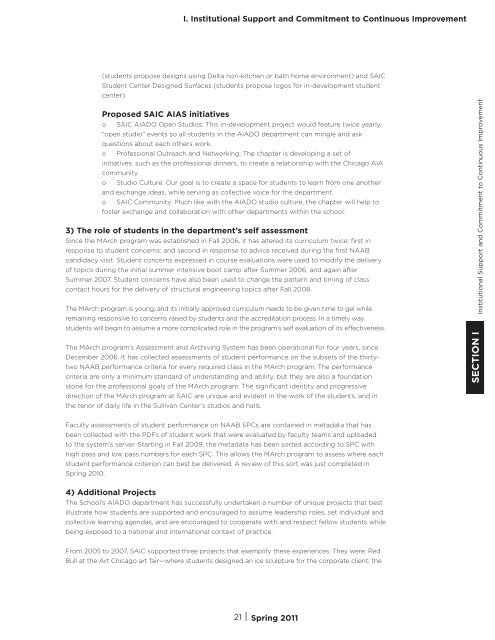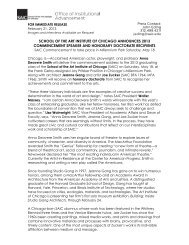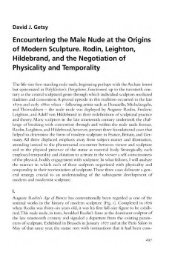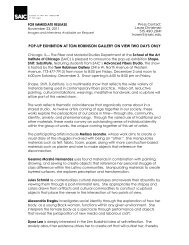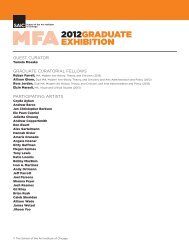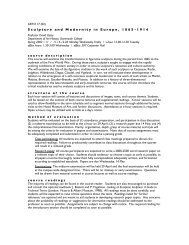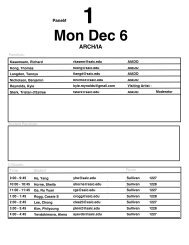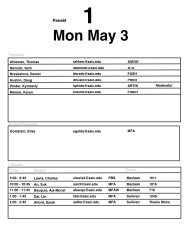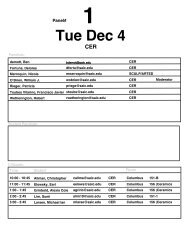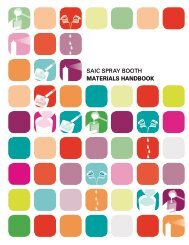i. institutional support and commitment to continuous improvement
i. institutional support and commitment to continuous improvement
i. institutional support and commitment to continuous improvement
Create successful ePaper yourself
Turn your PDF publications into a flip-book with our unique Google optimized e-Paper software.
I. Institutional Support <strong>and</strong> Commitment <strong>to</strong> Continuous Improvement<br />
(students propose designs using Delta non-kitchen or bath home environment) <strong>and</strong> SAIC<br />
Student Center Designed Surfaces (students propose logos for in-development student<br />
center).<br />
Proposed SAIC AIAS initiatives<br />
o SAIC AIADO Open Studios: This in-development project would feature twice yearly,<br />
“open studio” events so all students in the AIADO department can mingle <strong>and</strong> ask<br />
questions about each others work.<br />
o Professional Outreach <strong>and</strong> Networking: The chapter is developing a set of<br />
initiatives, such as the professional dinners, <strong>to</strong> create a relationship with the Chicago AIA<br />
community.<br />
o Studio Culture: Our goal is <strong>to</strong> create a space for students <strong>to</strong> learn from one another<br />
<strong>and</strong> exchange ideas, while serving as collective voice for the department.<br />
o SAIC Community: Much like with the AIADO studio culture, the chapter will help <strong>to</strong><br />
foster exchange <strong>and</strong> collaboration with other departments within the school.<br />
3) The role of students in the department’s self assessment<br />
Since the MArch program was established in Fall 2006, it has altered its curriculum twice: first in<br />
response <strong>to</strong> student concerns; <strong>and</strong> second in response <strong>to</strong> advice received during the first NAAB<br />
c<strong>and</strong>idacy visit. Student concerns expressed in course evaluations were used <strong>to</strong> modify the delivery<br />
of <strong>to</strong>pics during the initial summer intensive boot camp after Summer 2006, <strong>and</strong> again after<br />
Summer 2007. Student concerns have also been used <strong>to</strong> change the pattern <strong>and</strong> timing of class<br />
contact hours for the delivery of structural engineering <strong>to</strong>pics after Fall 2008.<br />
The MArch program is young, <strong>and</strong> its initially approved curriculum needs <strong>to</strong> be given time <strong>to</strong> gel while<br />
remaining responsive <strong>to</strong> concerns raised by students <strong>and</strong> the accreditation process. In a timely way<br />
students will begin <strong>to</strong> assume a more complicated role in the program’s self evaluation of its effectiveness.<br />
The MArch program’s Assessment <strong>and</strong> Archiving System has been operational for four years, since<br />
December 2006. It has collected assessments of student performance on the subsets of the thirty-<br />
two NAAB performance criteria for every required class in the MArch program. The performance<br />
criteria are only a minimum st<strong>and</strong>ard of underst<strong>and</strong>ing <strong>and</strong> ability, but they are also a foundation<br />
s<strong>to</strong>ne for the professional goals of the MArch program. The significant identity <strong>and</strong> progressive<br />
direction of the MArch program at SAIC are unique <strong>and</strong> evident in the work of the students, <strong>and</strong> in<br />
the tenor of daily life in the Sullivan Center’s studios <strong>and</strong> halls.<br />
Faculty assessments of student performance on NAAB SPCs are contained in metadata that has<br />
been collected with the PDFs of student work that were evaluated by faculty teams <strong>and</strong> uploaded<br />
<strong>to</strong> the system’s server. Starting in Fall 2009, the metadata has been sorted according <strong>to</strong> SPC with<br />
high pass <strong>and</strong> low pass numbers for each SPC. This allows the MArch program <strong>to</strong> assess where each<br />
student performance criterion can best be delivered. A review of this sort was just completed in<br />
Spring 2010.<br />
4) Additional Projects<br />
The School’s AIADO department has successfully undertaken a number of unique projects that best<br />
illustrate how students are <strong>support</strong>ed <strong>and</strong> encouraged <strong>to</strong> assume leadership roles, set individual <strong>and</strong><br />
collective learning agendas, <strong>and</strong> are encouraged <strong>to</strong> cooperate with <strong>and</strong> respect fellow students while<br />
being exposed <strong>to</strong> a national <strong>and</strong> international context of practice.<br />
From 2005 <strong>to</strong> 2007, SAIC <strong>support</strong>ed three projects that exemplify these experiences. They were: Red<br />
Bull at the Art Chicago art fair—where students designed an ice sculpture for the corporate client; the<br />
21 | Spring 2011<br />
SECTION I Institutional Support <strong>and</strong> Commitment <strong>to</strong> Continuous Improvement


